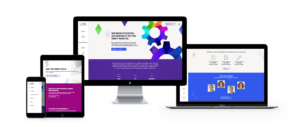The COVID pandemic has put a pause on many personal and business practices, with one stand-out exception. In the midst of COVID, digital transformation hasn’t slowed; instead, it’s actively accelerated as we try to keep up with today’s digital customers. “Digital transformation” has become a powerful buzz-word that has executives signing checks left and right. Many companies are investing heavily in digital, and while these investments continue to grow, the expected results often fail to materialize. But why? Technology and unsuccessful efforts to scale are often the first things we look to blame, but the real issue may be more deeply rooted.
Digital Transformation Requires a Culture Shift
In order to successfully execute a digital transformation, change must be driven from the top down. Beginning with management, the company as a whole must not only understand the goals and reasons for changing, but also the urgency for doing so to successfully prepare for a more digital future.
Companies are getting 50% more business and leads online than ever before, and this number will only continue to grow. To capture this ever-expanding market, it’s important to understand that the tactics and processes that got you to this point need to be an ongoing initiative. Digital transformation is often not one and done, it will not be sustainable without the future introduction of more digital practices.

How Can You Avoid Digital Transformation Failure?
You can start by making sure your team is on the same page regarding what tactics and strategies will make your business successful in the digital age. One method many companies are using to enter the digital space is through digital briefing centers and virtual events. Engaging the entire leadership team as well as your customers in the virtual space is a great way to lead a digital transformation in a world where fewer interactions are in person. Digital briefing centers also have the ability to be available at any time of day, allowing prospects to access your content at their convenience, not yours.
In today’s virtual world, differentiation through digital engagement is critical. Take a look at Bluetext’s work in the Digital Briefing Center space and find out how you can recreate the in-person experience.
Watch Bluetext founder, Jason Siegel, discuss the ways you can avoid digital transformation failure with Travelocity Founder and keynote speaker Terry Jones in this week’s Virtual Marketing Minute.
A fantastical idea, a powerful pitch, and energetic enthusiasm from all sides of SonicWall stakeholders. Only one task remaining: execution of the over the top Boundless Campaign.
SonicWall came to Bluetext with one main objective: bring their Boundless Cybersecurity campaign to life. As such, the SonicWall team needed creative assistance in bringing the campaign visuals up to par with their brand value. The Bluetext team was asked an age-old question of B2B companies, “How can we make this campaign memorable?”
Especially in the saturated cybersecurity market, it can be challenging to differentiate from strong competitors and help visual abstract brand promises. So the Bluetext team presented a thought-provoking approach to the campaign’s new creative and campaign taglines.
“When cyber threats are limitless, your defenses must be Boundless.” Break free with SonicWall Boundless Cybersecurity.
To communicate and contextualize this message, Bluetext presented a creative direction that would showcase the end-user in a gravity-free surrealist state, which literally breaks free of the constraint of cyber threat. The creative would be scaled across main industry verticals in order to personalize and target advertisements. The idea was over the top, innovative, and ambitious but well-received with client buy-in. Next came the challenge of execution, which was overcome using a custom photoshoot complete with realistic costumes, props, and even a trampoline. In order to achieve the effect of floating in an anti-gravity state, professional ballet dancers were hired to jump on the trampolines. Photographers captured the dancers posing mid-air, then flipped the photo 180°.

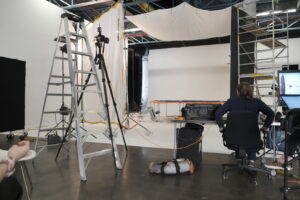


Once the in action shots were captured, the images were edited to remove the backgrounds and impose on industry-specific scenes. Related props were also imposed onto background images to make the scene appear as if person and objects had been magically released from the pull of gravity while the world remains grounded around them.

 At the time of the new Homepage and campaign landing page launch, these static images truly came to life with a subtle parallaxing effect.
At the time of the new Homepage and campaign landing page launch, these static images truly came to life with a subtle parallaxing effect.
To drive users to these newly premiered pages, SonicWall needed eye-catching advertisements that viewers would — no pun intended — gravitate to. Bluetext designed a variety of verticalized static banner ads and further animations to drive page traffic.
Your website acts as an essential business tool — used across every industry for a diverse number of functions. B2B companies rely on their websites to generate leads, phone calls, or physical location visits. No matter what function your website serves, there is one universal goal every business wants to accomplish with its website: leveraging it to create more growth.
There are several ways to increase your leads, sales, and revenue without investing in a complete redesign and rebuild. A great website will enable your team to work smarter, not harder. Here are tips that you should consider trying — while simple, they can help your business grow significantly.
1. Responsive Design
Mobile accounts for over half of global website traffic; if your site isn’t mobile-friendly, you may be losing valuable leads. In the coming years this number will only increase, and ensuring a mobile-friendly design may be crucial to your future success. A responsive website design (RWD) adapts to fit any screen in a way that makes all pages, features, and actions accessible to users. Making sure that your website can support traffic on any browsing device ensures that users are not dropping off your site because they cannot access what they’re looking for.
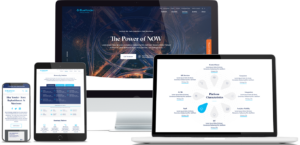
2. Simplify Your Navigation
In order to increase conversions, you need to keep users on your website. When a user lands on your website, they should be able to quickly and intuitively navigate to relevant content, allowing them to find the information they need without losing interest. The first step to keeping a user on your site is maintaining a simple and intuitive navigation. Too many options will likely overwhelm your user; it is important to have a clear path for users to the action you would like them to take as well as the information they are looking for. Otherwise, they may look elsewhere.
3. Avoid Clutter and Complex Noise
While incorporating animation and motion on your website adds visual interest for users and helps your site stand out, it’s important to be aware of the balance between unique design and overly-complex noise. Too much movement can be overwhelming for your user and may detract from what they originally came to your website to achieve. A complex design can also negatively impact your site speed, potentially increasing bounce rate and affecting your SEO score. While finding a middle-ground between these two extremes can be difficult, it’s important to ask if new design elements will add value to the end-user.
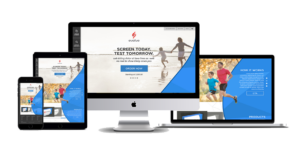
4. Don’t Go Crazy With Your Fonts
While fonts are an easy way to enhance your CVI and bring visual interest to your website, they may also be difficult to read for some users or on some devices. Using a Sans Serif font for your website’s body copy and making sure the font size and color meet accessibility standards is crucial in getting your message across to users. If they are not able to read the content on your site, they definitely won’t be converting.
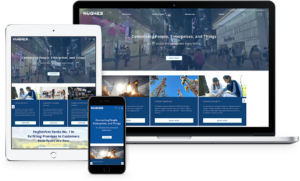
User experience is crucial to effective website design, but so is your internal team! Here are some tips to streamline the digital sales process for end-users and internal teams. A positive user experience will directly translate into increased conversions.
Use Call Tracking
If driving users to make a phone call is one of the main goals of your website, it is important to know which page has prompted the user to make the call. You can easily track this information by using unique phone numbers on different pages, allowing you to determine which page is driving the most traffic to your call center. These numbers can easily be configured to route to your main phone line, meaning there won’t be any disruption to the way you’re currently handling phone leads.
Install Live Chat
While live chat may not seem immediately relevant to your business, every website can benefit from this simple tool. Live chat functions to facilitate interactions with your users and enables them to quickly get the answers they’re looking for without spending too much time hunting around the site. Many chat services will also integrate with mobile phones, allowing your business to easily monitor traffic.
To learn more about driving leads via a responsive UX design and how Bluetext can help you increase conversion rates, contact us today.
Looking to jazz up your website? One of the hottest website design trends in recent years has been on page animation. But like any design decision, there are pros and cons. Bluetext top website user experience designers weigh in on the debate on how far you should go in injecting motion to your website.
To animate or not to animate?
Animation enthusiasts recommend adding motion to create a dynamic and flowing user experience. Not to mention, animation has been a major web design trend over the last few years, meaning your visitors are accustomed to seeing it on competitor sites and therefore expect a comparable experience on your pages. The opponents, or static supporters, on the other hand, will argue that animation is distracting and can seem unprofessional in certain industries. For example, B2B has traditionally been a strictly static and straightforward approach to website design, leaving the flashy frills to more consumer-based websites. However, having an interactive animated website could be a valuable point of differentiation. So what do the experts recommend?
Truth be told, animation can be a wonderful addition to a website’s aesthetic and functionality, but only when executed in the right way to fit your broader business goals. Careless integration of animations into your web design scheme can be a real eyesore and have negative impacts on site speed, SEO, and user experience. Weighing these pros and cons carefully, Bluetext website user experience designers recommend subtle animation and keeping in mind the following considerations.
Not all animations were made equal! Motion design spans a wide breadth of categories. Bluetext recommends the following types for a professional, yet modern feel to your site.
1. Loading Animations
Loading animations can be used as an effective way to engage users from the get-go. Since it only takes a user 3 seconds to abandon a page if the content doesn’t load, the use of loading animations offers content right from the start. Animated typography, countdowns, or a simple animated logo allow users to have fun watching while waiting for the site to load.
2. Micro-Interactions
Taking a cue from the mega “micro” trend sweeping the digital marketing industry (microtargeting and micro-moments sound familiar?)This effect is one of the hottest trends of website design. These are used to make small interactions (such as clicking a button) quick and clear for the user. Hover effects are one of the most well-known examples of micro-interactions. Certain page elements, such as navigation buttons, CTAs, or linked images, are the ideal canvas for mico animations.
3. Page Transitions
Subtle animation can be purposefully to ease the navigation from one component to another and between pages. Arrows, background scrolling, load bars, or any component that offers directionality to the user are great opportunities to use this effect.
4. Parallax Scrolling
Using full-width imagery, this effect takes the user on a cohesive journey as they move down the page. By definition, the background moves at a different speed to the foreground elements, creating a visually stunning effect on either full-page backgrounds and strips. While this is sure to give a wow-factor to your main website, it’s important to remember this effect is not available on mobile devices.
5. Decorative Delights
While these effects do not offer any functional benefits, they can be used to add more interest to the page. While it might be difficult to imagine serious B2B websites using these layouts, this might be exactly what your site needs to spice up drier content sections. Especially when placed near elements intended to draw attention, such as new messages, lightboxes, key CTA buttons, this turns aesthetic pop into actionable results.
With so many options for website motion, it can be tempting to want to do it all. However, top website designers have one golden rule: moderation is key. This rule doesn’t just apply to junk food, overdosing your site on fun animations can overwhelm the viewer and distract from the most important aspect: the content! Use animation sparingly and strategically. Before you fall in love with a beautiful design, consider the practicality. There are instances when animation could actually detract from your site, for example, if it hinders a user’s ability to read important messages or complete a conversion. For instance, you shouldn’t add animation to text paragraphs because it will make reading them much harder. You also would not want to add animations to fields where visitors enter their own content (such as a contact form or comments), because it would distract them from completing the task. When considering embedding motion effect, pressure test your decision against these questions:
- Does the site’s movement guide the viewer when to scroll and where to click?
- Does the animation support brand storytelling by gradually revealing information?
- Does the animation help a viewer visualize your product or service’s impact?
- Does this effect break up static scroll?
If you can answer yes to these questions, feel free to act on your motion goals! As long as you consider functionality first, animation can be a powerful visual tool to capture your audience and drive them deeper down the sales funnel.
Are you looking to drive users to your website using animation, but don’t know where to begin? Get in touch with Bluetext.
Have you ever found yourself on a website, staring blankly at the screen wondering where the rest of the pages are? Navigation is one of the most important functions of any web page whether it be a blog, product listing page, about section, or a document library. If your user doesn’t know where this content is housed, the utility of the information is lost! As a crucial element of user experience, failing to build smart navigation into your digital interface can lead to a variety of issues including secondary UX issues, accessibility problems, and increased bounce rates from frustrated users.
Let’s take a step back; what is a navigation menu, and do I still need one if I have “search”?
Navigation menus are maps of the categories or features of your content; on websites, these are known as sitemaps. These menus can appear in a variety of ways; from the traditional header locked navigation bar, to hamburger menus that pop out to link to various interior pages of a website.
While many websites have a Search function of some kind, whether it be a search bar or filter, research shows that 70% of users rely on navigating to content directly. While search features are helpful to some users, navigation menus can lead your visitors to the content they need quickly and reliably.
No matter where you are with your website, here are some quick, easy tips to help you optimize your platform for a better user experience.
1. The 3 Click Rule
Your navigation structure should be intuitive and allow users to land on any page and find what they are looking for in 3 clicks or less.
If your site has lots of content and sub-pages that relate back to a greater unifying category, take advantage of breadcrumbs. Breadcrumbs are a component of navigation menus that help users orient themselves within a sitemap. They can be embedded into the navigation bar as a dropdown, or appear in the design of the child pages on your site to guide users through the various layers of content.
2. Show Off Your Menu
Don’t try to reinvent the wheel-don’t hide your navigation menu! When a user visits your site, it’s likely one of the hundred other web properties that they have browsed in the last few days. As our digital lives have progressed, users have become accustomed to certain kinds of queues and user interface (UI) elements. Keep your navigation menu in an intuitive location, be that the left rail, top of the browser window, or a pop-out hamburger menu with an obvious icon.
3. State the Obvious
Be as clear and descriptive as possible. Avoid using vague descriptions in your navigation headings. If a user can’t tell exactly what to expect from a page in the navigation, there’s a chance they won’t make it past the landing page. Use descriptive language to identify what your pages contain, less is more with heading titles. Streamline the main menu display experience where possible and take advantage of dropdown menus for categories with multiple child pages. If you hyperlink to pages within your site from banners or in-line content, make your hyperlinks obvious!
4. Stay on Topic
Don’t let SEO impact your navigation taxonomy. While ranking well in search engines is important, packing your Headers and menu items with keywords that don’t relate to the page contents won’t do you any favors with users. Avoid this common pitfall by using the copy and metadata on your pages for SEO strategies, leave your headings and menu items clean and accurate for better UX.
5. Lead with a Mobile-First Mentality
Over 53% of all web traffic occurs on mobile devices. When designing your navigation menu, start by thinking about how users might visit the site; on both their computers and mobile devices. Take advantage of responsive designs that can adapt to a variety of browsers and devices rather than discovering post-launch that your navigation is broken.
6. Stop Guessing! Test Your Audience
If you’ve updated your navigation menu but still see disappointing numbers for bounce rate and click through on your site, test your experience. User behavior can be monitored with tests such as a Crazy Egg Heatmap, which illustrates where your users are browsing on the page.
TLDR: improving your navigation design can improve your relationship with users
Confusing or obscure navigation will lead to fewer visitors to your interior pages and can result in awful analytics reports. Clear and effective navigation can enhance visitors understanding of where your content is located, instill confidence in browsing your site, and create credibility about your product.
Do you need to up your navigation game but you’re not sure where to start? Get in touch with us.
The recent COVID-19 outbreak has had ripple effects across almost every industry. Around the world, the global pandemic has altered the way we live, socialize and even conduct business. In this unprecedented scenario clouded with uncertainty we all, especially digital marketers, are wondering: What needs to change? And how drastically?
When it comes to search engine optimization strategies, digital marketing and content agencies are continually researching the latest trends and evolving best practices. In the current environment, the role of a top digital marketing agency is to keep a pulse on the present, while also looking forward to strategies that will drive long-term success. Here at Bluetext, our digital marketing analysts are harnessing a variety of tactics to support overall business goals and serve users the best we can during these uncertain times. Check out the top ways we’ve been monitoring and optimizing around current events.
Strength in Numbers
When in doubt, trust the data! Using top marketing analytical tools, such as SEMRush and Moz, one can track the aggregate behavior of online users. Gathering the most up to date data can be tricky, so don’t do it alone. The more expertise and tools, the better. Trust a marketing analytics agency to help break down the numbers into a comprehensible story of website traffic. Use professional tools, such as Google Analytics and Google Search Console, to monitor the recent fluctuations in your page traffic. Do a keyword analysis of your current keyword list to see if search volume has shifted. Google Trends page is a great tool to identify emerging patterns. Are there new phrases your customers are searching for? If the language has evolved, so should your SEO strategy. If you have chatbots for customer service transcripts, these can provide valuable insight into current needs.
In short, the data doesn’t lie. Businesses need to understand search traffic shifts to get as clear as possible a picture into whether to pivot your SEO strategy or not.

Content is King — Still
Ultimately any changes to your SEO strategy should be driven by your unique business needs. For example, a brick and mortar store will need to cater to how they can serve customers at home. If your business was already available online, you may be experiencing altered user behavior as people spend more time at home and online. Every business should ask: “Is the content relevant to current needs?” Your messages may need to shift in sensitivity to the current environment. A complete overhaul is not necessary, nor appropriate. However, if there are opportunities to generate new content that supports your users in a unique time, do so. And if your business is considered essential or has been significantly impacted, you should create a dedicated page to capture all relevant coronavirus traffic. Keep the page simple, focused and sensitive. Don’t try to provide the latest breaking news, but exactly what and how your company is doing. If your business has been minimally affected, perhaps there is an opportunity to contribute to emerging conversations. Exploding Topics is a valuable tool for up-to-date trends across search engines and social media mentions. At the end of the day, users are seeking timely and accurate information now and long after the dust has settled on this pandemic.
 Optimize Often
Optimize Often
Search engine optimization is never a “one and done” task. Any digital marketing strategy requires upkeep as is the nature of the evolving industry. Now, more than ever, flexibility is paramount to staying afloat. Be proactive, be vigilant. SEO strategy will need re-evaluation in the upcoming weeks and months. No one can predict how long the pandemic will last so you must be ready to pivot to any new or resurging customer needs.
In an unpredictable environment, one thing is certain: this is our new (remote) reality. Don’t expect old strategies to work as they once did, and don’t expect this shift to “blow over soon”. Your business should be prepared to remain relevant now more than ever. There will likely be long term implications in behaviors and business operations. Get behind the shifts now and flex your agility. It will pay off in your long term business health.
If you’re looking to partner with an agency to pivot your SEO strategy, let us know.
As of late, communications have been drastically changing, and companies have had to adapt quickly and swiftly to accommodate the current COVID-19 environment. It is a new and unprecedented scenario, forcing flexibility and fast thinking to all aspects of the business. As work-from-home policies and entirely virtual communications surge, recruitment strategies have been greatly impacted. How a company reacts to this digital shift and adapts various business models is crucial to future success following the return to normalcy.
Improving Remote Recruiting & On-Boarding
Learning how to better recruit and virtually onboard, not only during COVID-19 but throughout a company’s entire lifespan, is essential. It demonstrates your company’s ability to stay flexible, proactive, and conform to different comfort levels.

Have a Convincing & Personalized Careers Page
Virtual recruiting isn’t a novel idea. Companies have been trying to actively attract new talent online for years. However, in order to get a great pool of new hires, you need one thing: an outstanding career section on your website. Your career section is the portal for all potential new employees to investigate your company, culture, benefits, growth opportunities, and what you are all about. This is your first impression to prospective employees, who are most likely browsing opportunities at multiple companies! The main mission of a career section is to make the biggest impact in the shortest amount of time. How do you do this? With the proper targeting.
Proper targeting isn’t all about spending large sums of money on paid media. It’s important to utilize your current resources and current employees to create a lasting campaign. Centauri, a technology-driven company providing high-end, creative software and engineering solutions to critical national security missions, came to Bluetext wanting a recruitment-focused campaign. Looking at the diversity in the age, specialty, race, gender and backgrounds of current employees, Bluetext created a range of different personas. Backtracking to Marketing 101, persona creation is a critical step in marketing to the right audience. It’s crucial to know a user’s specific goals, interests, and motivations. For example, a young college graduate student will have different goals versus an experienced middle-aged military veteran. By creating personas, potential employees are able to connect more with someone that closely resembles them. For proper targeting, personalization is key. The career section should play into all personas, create hyper-specific content and show the user relevant jobs pertaining to them. Sound like a lot of legwork? Digital marketing agencies, such as Bluetext, are experienced and proficient in persona creation and targeting strategies.
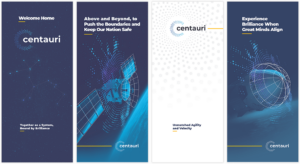
Leverage Alumni Networks
Another great way to better recruit qualified candidates is to create an Alumni Network. This can take many forms, with the most popular being an informal social media group harnessing Facebook or Linkedin). This creates a space for alumni to connect with others, share thoughts, and best of all, provide valuable leads. Not only are you getting free referral lead generation, you nurture an excellent relationship with the company even after the employee has left. It creates brand ambassadors who are constantly promoting your company in a positive light, possible future business partners, and topnotch re-hires.
Institute a Welcoming Virtual Onboarding Process
While virtual recruiting was surging in popularity even before COVID-19, virtual onboarding is relatively new. Companies like Amazon have already begun to virtually onboard thousands of new hires to keep up with higher demands. The biggest concern for most employers is exactly how to bring a newly-hired employee into the company and properly integrate them.
Onboarding is the first time a new employee gets a true first impression of the company in action. Maybe new hires came into the office to interview, but this is the real introduction to the nit and grit of day to day tasks. The first day typically involves numerous face-to-face meetings and handshakes–both no longer possible amidst the COVID pandemic. When virtually onboarding, It’s important to utilize scheduling software, internal communication platforms, and video conferencing tools in order to keep the initial introductory phase as personal, engaged, and genuine as possible. This is especially important for one-on-one meetings with direct managers.

Being able to leverage current new-hire learning processes virtually is a huge focus as well in the current environment. Do your new hires get a “Welcome Binder?” Replace that with a consolidated folder filled with the online version. Do you typically run through various Powerpoints with your new hires? Think about translating those into short, educational shared videos. Are there various informational sessions for new hires? Leverage video conferencing and screen sharing tools. Translating your in-person process to online can be done by almost anyone. In fact, the more people involved the better! Have multiple employees help create onboarding videos so that new hires get introduced to a wider breadth of the company.
The main goal of your virtual onboarding should be to make the new hire feel comfortable. Make sure to over-communicate and offer assistance as much as needed. Be sure they are understanding expectations laid out and asking questions when they feel confused. Make sure they get proper introductions, are included in virtual activities, and let them truly shine.
Virtual recruiting and onboarding are of utmost importance right now, but companies will benefit by taking advantage of these now and implementing these processes for all future recruiting and onboarding processes and the industry shifts. At Bluetext, there is no limit to the amount of success we can help you achieve. To learn more about our processes and to see our work, check out our case studies.
Ready to partner with Bluetext to achieve your marketing goals? Schedule a call with us today.
As the world has changed in the blink of an eye, so has the way we market to consumers. Now, more than ever, your website exists as BY FAR THE MOST IMPORTANT doorway to your brand and your brand experience. While stores stay shut, and face-to-face interaction is vastly limited, brands will rely on reaching their target audiences via their websites. Therefore, your website is mission-critical to your success.
Website accessibility, or the practice of ensuring websites are available to everyone, regardless of their abilities, has always been a crucial part of website design and development. But as website accessibility gains momentum, meeting and exceeding accessibility standards has become even more top-of-mind. Website design and development agencies have begun to ingrain accessibility standards into their designs; meeting these requirements is no longer a “nice-to-have.”
Accessibility Requirements Are Legal Requirements
According to Dean Schuster, user experience design strategist, “In 2019, the United States Supreme Court upheld the notion that all sites conform to the W3C’s Web Content Accessibility Guidelines (WCAG) AA standard.” With these requirements now legal requirements, website design and development agencies have upped their game to ensure their websites are readily accessible to anyone who wants to browse.
ADA compliance is now established legal precedent for U.S. websites. At a high level, accessibility regulations are broken out into four categories: Perceivable, Operable, Understandable, and Robust. In other words, all content must be “POUR”:
- Perceivable: Users must be able to perceive the information that is being presented. Perceivable guidelines include text alternatives for any non-text content, time-based media alternatives, adaptability, and distinguishability.
- Operable: Website components and navigation must be operable. These guidelines include keyboard accessibility, providing enough time for users to read and use content, providing navigable content, and providing input modalities.
- Understandable: Users must be able to understand the information and the operation of the user interface. Understandable guidelines include readability, predictability, and input assistance, or helping users avoid and correct mistakes.
- Robust: Content must be robust enough to be interpreted by a wide variety of users, including assistive technologies.
Ensuring your website is accessible can be overwhelming, which is where website design and development agencies come in. Building and maintaining an accessible website starts with the design and development process.
 Meeting Accessibility Standards Begins with Design
Meeting Accessibility Standards Begins with Design
Ensuring website designs are accessible to all impacts the entire website design process; designers must think long and hard about the limitations of visual formats. Often, we deem the skills we learn within a certain context as “normal.” Increasingly stringent accessibility standards will require designers to step outside of their “normal” and rethink each design through the lens of a website user who may not be as abled as they are.
The transition from professional website designer to accessibility expert is well underway and this transition will only accelerate as 2020 progresses.
Website Development Impacts Accessibility at a Foundational Level
Website designers are not the only ones affected by stricter accessibility regulations – website developers will also be impacted at a foundational level. Developers must constantly work to maintain knowledge of the continuously evolving standards and best practices, accounting for practical use-cases within the disabled community while using caution when approaching newer programmatic technologies.
Website designers and developers who stay ahead of this trend and embrace website accessibility are positioned to deliver more accessible products. As standards and best practices continue to evolve, website design and development agencies must continue to meet the criteria necessary to ensure that their websites are accessible to everyone on the internet.
Use Your Online Presence to Empower the Disabled Community
When translating your business to the digital world, a lot of thought goes into making sure your business is represented correctly; between your corporate visual identity and the messaging that makes your business unique, each of these foundational building blocks come together to create a unified online presence. Your online presence should be accessible to everyone, including the 18.7% of Americans with a disability. Supporting these users and ensuring your website offerings are accessible to everyone on the internet should always be a top priority, regardless of the legal ramifications.
To learn more about our experience pertaining to accessibility, check out our case study featuring our work with Level Access, the leading provider of accessibility solutions and software.
It’s no surprise that video has taken the digital ad space by storm. It’s rare that you scroll your newsfeed or surf the web without being served an ad that is relevant to your specific interests. In 2019, 87% of marketing professionals were leveraging video in their media strategies and more than 80% of video marketers saw a stronger ROI than when they ran static banner ads or paid social image ads.
So, why are video ads so popular? And why should marketers continue to invest in video advertising in 2020?
Expanded Inventory
For starters, video inventory is incredibly robust. You can reach users across a variety of different platforms and sites – from social platforms to Connected TV devices. That’s right, you can now tailor ads to reach users while they’re streaming a show through their smart TVs. Marketers can also place video pre-roll ads across premium website inventory, along with video-specific platforms like YouTube, where ads play before or during video content that a user is viewing.
Video ad inventory has expanded across social platforms in the past few years as well, and the results have been significant. Platforms such as Instagram and Facebook see 49% higher interactions on video ads than with image ads. With such impressive engagement metrics, it makes sense that marketers are investing more of their media dollars into paid social video ads. In fact, paid social video ad spend accounted for 28.7% of all video ad spending in 2019 ($10.35 billion). This number is projected to grow to $12.48 billion in 2020.
Unique Ad Formats
The unique ad formats offered through video is another reason why marketers are investing more of their paid media budget into the medium. Sprout Social reports that marketers are increasing their digital video budget by 25% year-over-year due to the increase of new ad formats. For example, marketers are now leveraging Instagram stories to connect with users for :15 seconds through an immersive experience with a full-screen interactive video. In 2019, one-third of Instagram’s most-viewed stories came from businesses, and 20% of those stories drove users to directly message businesses.
Another evolving ad format that businesses are taking advantage of is YouTube’s 6-second bumper ad. YouTube bumper ads are non-skippable, and while quite short, marketers have been able to successfully story-tell through a sequence of these 6-second ads. Google Ads shares that “many large brands are using bumper ads to drive upper-funnel goals like ad recall and awareness…. [they] are a cost-effective way to reach your target audience, ensure your message is seen and heard, and keep you top of mind.”
As mentioned previously, the ability to target users through Connected TV (CTV) devices is a huge win for marketers. There is a shift happening between traditional TV and CTV; many households are ditching cable subscriptions and switching to subscriptions with streaming services such as Hulu, Amazon Prime and Apple TV to get their news and entertainment. By 2022, it’s projected that 35 million viewers will watch TV exclusively through streaming services. The result? Marketers are investing less in traditional TV commercials, and instead, putting those dollars behind non-skippable :15, :30 and :60 second CTV ads. The best part of CTV advertising is that you actually have access to ad data! With traditional TV, networks will provide projected impressions for running commercials during specific time slots; however, with CTV, you’ll know exactly how many users watched your ad, along with viewability metrics and insights into ad recall.
The Future of Video
While banner and image ads have seemingly run their respective courses, the future of video advertising looks promising. With new formats and campaign functions rolling out across platforms specifically for video, marketers should set aside a healthy media budget for testing new video opportunities in 2020.
One new practice that Google Ads recommends is to make your video and search ads work together. Google Ads states that marketers who run search and video together will experience a 45% higher lift in ad recall, and a 180% higher message retention. One brand, in particular, found that running video alongside paid search led to a 4x increase in branded search, and dropped their CPA by 70%.
Another new trend popping up across paid social is the use of live video. Marketers are investing in live video as a means of building trust and transparency with consumers. We’re used to seeing this trend across Instagram and Facebook Stories, and video-first platforms like Snapchat. However, some businesses are migrating live video to LinkedIn to help tell brand stories and to show followers the real people behind the company name. Live video is helping to break down walls and let users connect with businesses in a personal way.
Other new video opportunities coming our way are: shoppable video ads, augmented reality campaigns, new possibilities on IGTV and Facebook Watch, and so much more.
Bottom line: Invest in video advertising in 2020. You’ll be glad you did. Find out how Bluetext has leveraged video ads in successful go-to-market campaigns.
This Sunday, the Kansas City Chiefs will square off against the San Francisco 49ers in Super Bowl LIV; anticipated to be one of the most entertaining sporting events of the year brought to you by gunslinging quarterbacks Patrick Mahomes and Jimmy Garoppolo.
Thanks to two electrifying football teams and the unofficial holiday that comes with Super Bowl Sunday, a projected 100+ million viewers in the U.S. will tune into FOX at the same time, creating an unparalleled opportunity for marketing pros to cultivate a memorable brand association with more than a quarter of the U.S. population.
But these opportunities do not come cheap
Outside of the cost of producing the commercials, (which anyone in marketing can tell you isn’t cheap) you have to pay egregious dollar figures just to place it on the primetime Super Bowl stage. FOX sold out of its Super Bowl ad slots in late November, which reportedly sold for between $5 million and $5.6 million.
$5.6 million!
Let that number sink in. $5.6 million could buy you a five-bedroom house with a view of the Golden Gate Bridge in downtown San Francisco. Or 10 five-bedroom houses in the Kansas City-area. Suffice to say, there’s a lot you could do with that money.
From a marketing standpoint, if your brand is considering purchasing a primetime 30-second Super Bowl ad, or you’re simply wondering how you could make a splash during the event without blowing your entire annual budget, consider these marketing alternatives that you could buy for the same price:
1. 20 years of a PR retainer at 20K per month
While it probably does not make sense to stretch one year’s marketing budget over the next two decades, this illustrates how far your marketing dollar could go over time with a PR budget as opposed to a single, 30-second Super Bowl ad. A monthly PR retainer could produce the ability for your brand to demonstrate expertise to more targeted audiences than the general public watching the Super Bowl at a fraction of the cost. This is typically executed with media relations and strategic placements of messaging within publications of interest to the brand’s most important audiences. Spending your marketing dollars in this way would create a steady burn of messaging over a long period of time as opposed to one, 30-second firework explosion of your brand that a large portion of the Super Bowl audience could miss.
2. Multiple omnichannel digital campaigns
In order for any Super Bowl campaign to be successful, it must eventually migrate to the digital realm in one way or another. Outside of the $5.6 million it will cost to run the ad in the spotlight, brands also have to shell out at least another $1 million to market the ad via social media. So why not go straight to digital with your campaign?
Newcastle Brown Ale was among the first to attempt this digital-first Super Bowl strategy in 2014 with a satirical YouTube commercial featuring Anna Kendrick about the Super Bowl commercial they almost made but didn’t have the money. By posting the video directly to YouTube and spending all of their resources marketing the commercial online, they found a witty way to poke fun at the nature of Super Bowl commercials by making one while also saving A LOT of money in the process. Digital campaigns can be an extremely effective (not to mention more targeted) way of maximizing your exposure to your key audiences. Ultimately the third-party validation that will come from individuals sharing your content will be the mark of a successful campaign, so digital-first strategies could be the next iteration of Super Bowl commercials.
3. Yearly platinum sponsorships in ten of your audience’s favorite publications
If your brand is targeting audiences that congregate around specific media outlets, paid partnerships with those media outlets can be a great way to enhance your exposure to the people who matter most. Sponsorship packages at media publications vary based on their target audience, the type of content they typically publish, and what you’ll get for your spend. But with big dollar figures in the hundreds of thousands, you could expect millions of unique viewers, digital ad space, thought leadership content, lead-gen, sponsored webinars, and more!
As Americans and football fans around the world tune in to the game on February 2, household brands will be vying for your loyalty and lesser-known companies will be introducing themselves to the world on the hottest advertising real estate money can buy. However, you can also expect to see many organizations turning to alternative marketing to make their splash during the game.
The real winners of this international media event will not be limited to just the Chiefs or the 49ers, but also to the organizations who strategically employ ALL of the marketing tactics available to them.
 Optimize Often
Optimize Often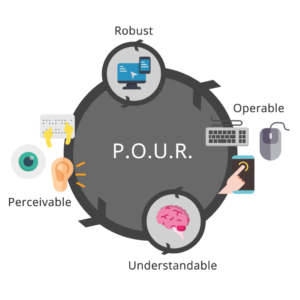 Meeting Accessibility Standards Begins with Design
Meeting Accessibility Standards Begins with Design